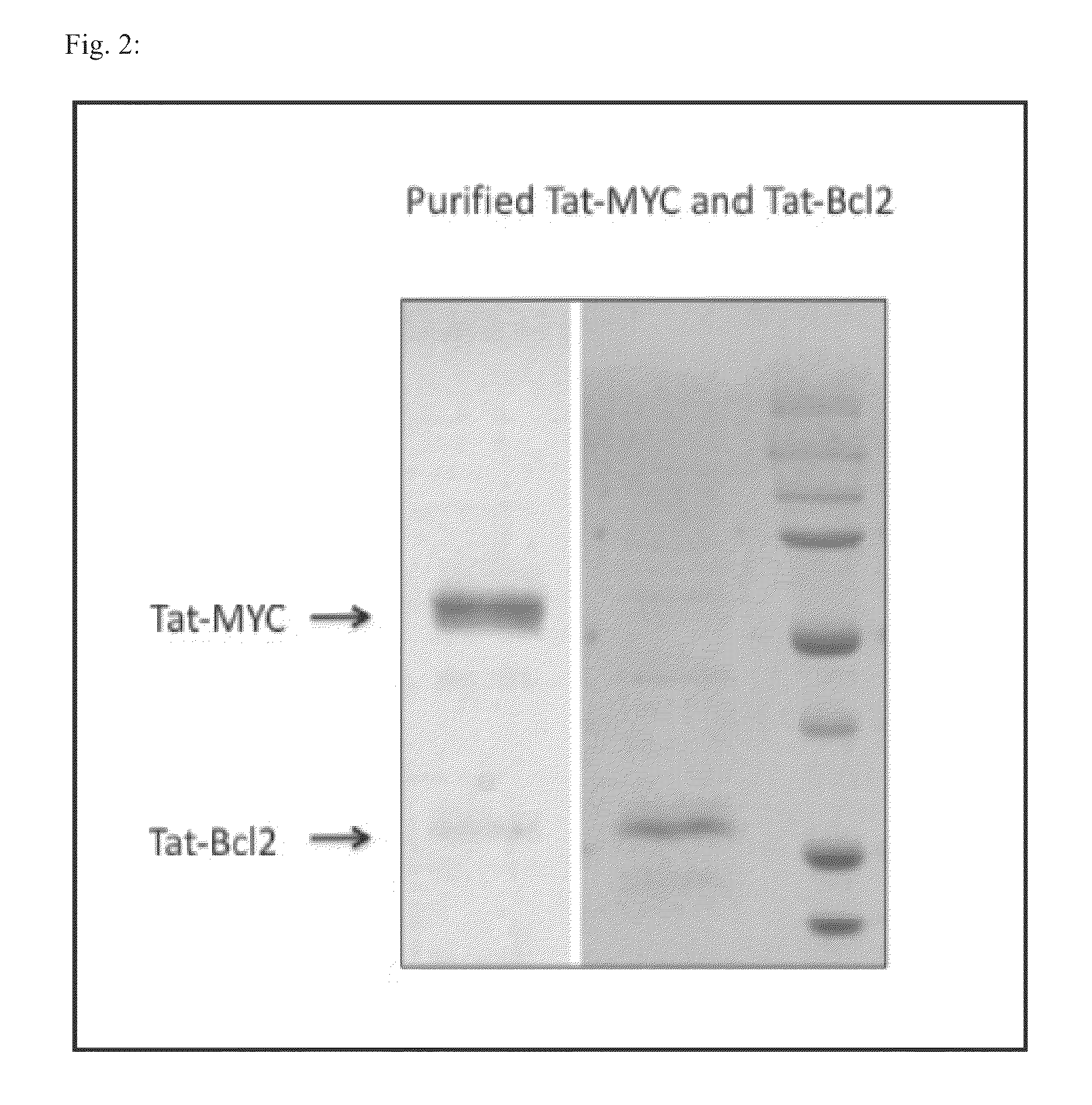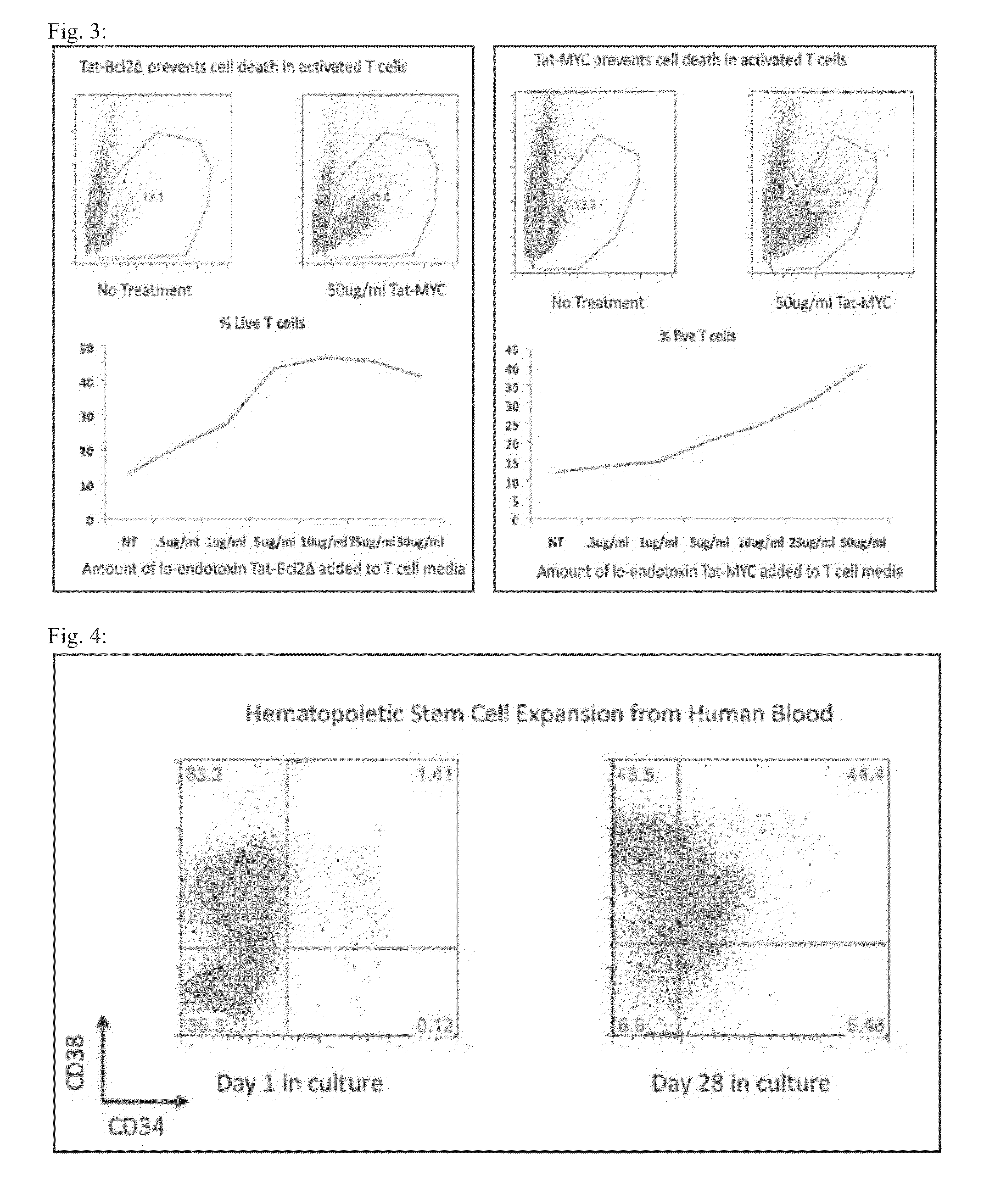Methods of generating xenochimaeric mice with tumor and hematopoietic system from the same heterologous species
a technology of hematopoietic system and xenochimaeric mice, which is applied in the direction of antibody medical ingredients, instruments, peptide/protein ingredients, etc., can solve the problem of poor prediction of clinical efficacy of approximation
- Summary
- Abstract
- Description
- Claims
- Application Information
AI Technical Summary
Benefits of technology
Problems solved by technology
Method used
Image
Examples
example 1
Improved Production of Purified Recombinant Tat-MYC and Tat-Bcl-2 Fusion Proteins
[0170]DNA encoding for Tat-MYC and Tat-Bcl-2 fusion proteins (human MYC and human Bcl-2 each fused to Tat from HIV-1) were cloned into bacterial expression plasmids (Invitrogen Gateway pDEST15 vector). The expression plasmids were transformed into Escherichia coli and overexpression was induced with IPTG. Induced cells were lysed in the presence of urea and the lysate was clarified and run on a nickel-affinity column. Fractions containing protein were dialyzed to remove the urea before being run on a size-exclusion column. Relevant fractions were pooled and endotoxins were further removed using an ActiClean column. A sample of the protein was run on a 15% SDS-PAGE gel and stained with a silver stain (FIG. 2).
example 2
Biological Assay for Purified Tat-MYC and Tat-Bcl-2 Fusion Proteins
[0171]Murine CD4+ T-cells were isolated from peripheral blood of mice injected with 10 ng / ml G-CSF. The stem cell population was activated with antibodies to CD3 and CD28 for 72 hours in stem cell media (Stemline II), typically 1 μg / ml each, supplemented with recombinant IL-3, IL-6 and stem cell factor (SCF). Cells were washed to remove the cytokines and live cells enriched on a Ficoll-Hypaque gradient. Live cells were then incubated in either media alone or media supplemented with either Tat-Myc (50 μg / mL) and varying amounts of Tat-Bcl-2 (0-50 μg / mL), or Tat-Bcl-2 (50 μg / mL) and varying amounts of Tat-MYC (0-50 μg / mL). For each concentration of protein, the percentage of live T-cells was determined by FACS through gating on the live cell population by forward and side scatter, as well as staining for live cells by exclusion of 7-aminoactinomycin D (7AAD) (FIG. 3). A similar experiment was conducted using B-cells in...
example 3
In Vitro Generation of Ctlt-HSCs Using Tat-MYC and Tat-Bcl-2
[0172]Human cord blood cells were used as a source to produced ctlt-HSCs. Red blood cells were lysed by incubating the cord blood cells in a hypotonic lysis buffer. The remaining cells were cultured at 2×106 cells / ml in Stem line media (Stem Cell Technologies) supplemented with IL-3, IL-6 and SCF as well as 20 mg / mL of each Tat-MYC and Tat-Bcl-2. Cells were incubated in 24 well plates in 1 mL of medium, with a starting density of 2×106 cells per well. The medium was replaced every two days. After 14 days, FACS data was collected to observe an increase in percentage of CD38+, CD34+ HSCs from 1.5% to 44.4%, demonstrating the expansion of lt-HSCs after incubation with recombinant purified Tat-MYC and Tat-Bcl-2 (FIG. 4). The total CD34+ HSCs in the culture was also regularly monitored, with regular increase in the total number of lt-HSCs demonstrating the formation of ctlt-HSCs (FIG. 5). Importantly, the total number of human l...
PUM
| Property | Measurement | Unit |
|---|---|---|
| Time | aaaaa | aaaaa |
| Time | aaaaa | aaaaa |
Abstract
Description
Claims
Application Information
 Login to View More
Login to View More - R&D
- Intellectual Property
- Life Sciences
- Materials
- Tech Scout
- Unparalleled Data Quality
- Higher Quality Content
- 60% Fewer Hallucinations
Browse by: Latest US Patents, China's latest patents, Technical Efficacy Thesaurus, Application Domain, Technology Topic, Popular Technical Reports.
© 2025 PatSnap. All rights reserved.Legal|Privacy policy|Modern Slavery Act Transparency Statement|Sitemap|About US| Contact US: help@patsnap.com



